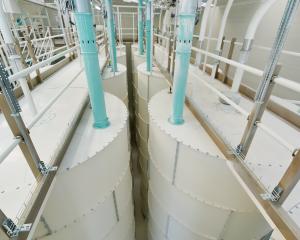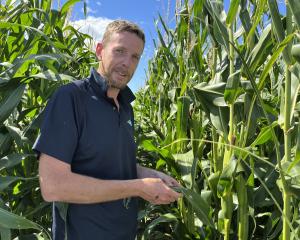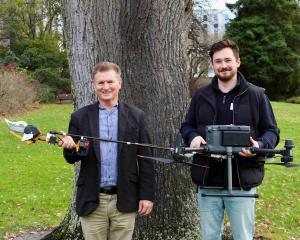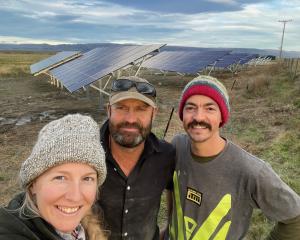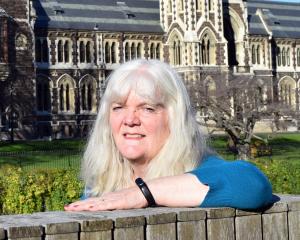
Nearly 50 people attended a DairyNZ event last week to learn how some Balfour Catchment Group members are installing wetlands and woodchip bioreactors as part of The Waimea Project.
The field day started on the 240ha arable farm Mains, owned and operated by Craig and Janette Collins in Balfour.
Mr Collins is the third generation of his family to work the free-draining soil of the flat farm.
The two previous generations had sheep in their operations.
"We got rid of our stock in 1996 and it has been cropped ever since."
Wheat was the main crop grown and the rest includes barley, peas and grass seed.
Water from a stream travels through a culvert at Stefan Rd to enter the farm and into a new large wetland.
"I had no problem giving up this land for it."
A lot of overburden, such as soil, rock and vegetation needed to be removed to build the wetland.
"The 25-tonne digger in it looked like a toy working away."
The wetland needed to be deep enough so when it was full of water, ideally 300mm deep or shallower for the wetland to be effective, its water level must be lower than the level of the culvert.
Water enters the wetland through a sediment trap and works it way around four baffles and then travels over a weir.
More than $74,500 had been spent building the wetland including nearly $46,000 on earthworks.
The next stop on the field trip was 720ha arable, sheep and dairy grazing property Strathmore, owned and run by Ian and Sandra Orr and their son Nathan, in Balfour.
Their family had been farming the land for more than 120 years.
Mr Orr said a woodchip bioreactor and two wetlands had been constructed on Strathmore.
"We had to get involved because we are pretty much the sink drain of the Balfour fan."
Another ongoing project on their farm was a riparian seepage area being planted.
The project research discovered the endangered gollum galaxiid fish lived in a drain in the area.
The Longridge Stream runs through the middle of the Orrs’ farm and the Waimea Stream runs along the bottom of their boundary.
Springs on the farm were highly active during a deluge last year.
"We thought we were draining all of the fan’s water because the place was wet as. As we have farmed here a long time, we have learned to deal with it."
Nearly $20,000 was spent on earthworks to construct a wetland and nearly $17,500 to plant it out.
Mr Orr had "reservations" on how effective the wetland would be.
"I’ll wait and pass judgement when we’ve had a few big weather events."
Mrs Orr said about 35mm of rainfall in April floated a pipe in the wetland.
"How much it filled up in a short amount of time was incredible."
Their son Nathan had to put a concrete post on the pipe to stop water overflowing from the wetland, Mrs Orr said.
"I was worried that the bank would be gouged away but the concrete post worked and it was an effort for Nathan — he got completely submerged twice."
A woodchip bioreactor was installed in a paddock nearby and cost more than $17,000.
Water flows through the bioreactor, a subsurface trench filled with wood chips, which serves as a substrate for bacteria that breaks down the nitrate.
Nathan said there was enough soil on top of the bioreactor on Strathmore to be able to plough it and plant a crop.
He was pleased his family’s farm was part of the project.
"It is future-proofing."
His son Hunter, 7, was the fifth generation on Strathmore and was "lining up to be a farmer".
"He has been with me on the farm since day dot so he is destined to be that way inclined."
Dairy farmer Brendon Stevens was the third and final catchment group member to talk about three new sites developed on his farm.
He just had his best season milking more than 600 Holstein Friesian cows on the milking platform which covers about half on his farm Wainui in Balfour.
On average, each cow produced about 565kg of milksolids last season, or 1460kg of milksolids per hectare.
Crops grown on the 500ha farm last season include about 400 tonne of wheat to crush for the cows to eat in the milking shed.
On Wainui, a terraced wetland was being built in a gully fed by a tile drain.
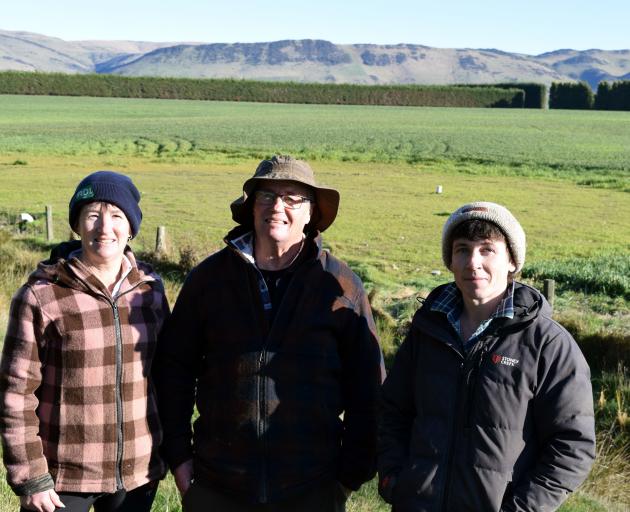
"It is a work in progress."
More earthwork would make the wetland more efficient.
A woodchip bioreactor has been installed on his farm.
About 300m3 of pine woodchips lies in a hole, 30m-long, 10m-wide and about 1.5m-deep.
A membrane lining was above and below the woodchip.
The bioreactor was estimated to cost about $30,000.
"I’m quite excited to have one of these on the farm because I’ve been looking at them for about 10 years and to have someone else pay for it is even better."
Soil, about 1m deep, was put on top of the bioreactor and the pasture was cut for silage or grazed by young stock.
A decision was made to install a bioreactor because establishing a wetland would have removed productive land from his system.
He believed the bioreactor life expectancy was more than 20 years but the technology was new so its lifespan was yet to be proven.
The third and final site on Wainui was a wetland under construction.
A budget of $15,000 for earthworks and $21,5000 for planting would create a wetland featuring three weirs.
Mr Stevens gave an overview on how Balfour catchment was selected to launch the Waimea Project.
A groundwater quality project was launched in Balfour in 2008.
The project was a response to consistently elevated nitrate levels in bores southwest of the Balfour town.
An aim of the project was to better understand the cause and the impact of the elevated levels to formulate a response to address the issue.
Environment Southland and the Primary Sector Water Partnership funded the project, which ran between 2008 and 2012.
In 2020, the Balfour Catchment Group was formed aiming to give farmers information on how they could make changes on-farm to improve the environment, which were economically viable and backed by science.
"It was focused on taking action and working together in a strong, purposeful community group."
The group launched the "Balfour Project", supported by funding from Thriving Southland, aiming to reduce groundwater nitrate levels and runoff of sediment, phosphorus and e-coli.
An early part of the project included the group collaborating with Land & Water Science to use radiometric sensors to create a soil map of the Balfour fan.
To verify the data, 14 soil pits were dug.
The first phase of the project also included getting a better understanding of the fan’s diverse soil composition, which provided significant insights on nitrate susceptibility.
A learning included "ancient" Benio soils being severely susceptible to nitrate leaching and younger Crookston soils being moderately susceptible.
"The Benio soil type is like having a louvre window that are fully open compared to the other soil types in the area."
Drone surveying was completed on four hill country properties in Northern Southland to create waterborne contaminant susceptibility maps, showing hydrology and erosion risk.
The maps could be used to guide decisions around mitigations to slow down the speed water leaves the landscape.
As a result of the mapping, farmers Chris and Andrea Bulleid installed detainment bunds.
The second phase of the project was to identify the pathways groundwater nitrates were entering the Longridge and Waimea streams.
A 90-page report "Beyond Hotspots: Landscape Understanding to Inform Practical Solutions for the Future of the Balfour Fan Community" details the findings of the work to identify the pathways for contaminant loss via overland flow and artificial drainage.
"This phase was very important because we could focus on the right solution for the right place. In my opinion, this is one of the most valuable outcomes as we can target the highest ranked sites first."
The final project phase focused on the mitigation opportunities identified in the second phase.
Mitigation concept designs were created with the assistance of John Scandrett, of Scandrett Rural.
Mr Scandrett reviewed the concept designs of the high-priority sites to ensure landowners’ expectations were met, mitigations were effective and they did not impede existing drainage and were simple, cost-effective solutions, which could be replicated elsewhere.
As part of the phase, Land & Water Science provided property specific reports on the Balfour fan.
The reports include a detailed soil map, analysis of soil types, detailed descriptions of soil properties and their implications for farm systems on their properties.
"It is exciting to see what these mitigations will be able to do for improving the water quality in the coming years in the Balfour and Waimea area."
DairyNZ senior environment specialist Justin Kitto, of Rolleston, said DairyNZ was given funding from the Ministry for the Environment, through Jobs for Nature, to support farmers to reduce their nitrogen loss to water while retaining profitable and resilient businesses.
"We were looking for a catchment to do something in Southland and we heard about the work of the Balfour Catchment Group and thought ‘boom’ there’s an opportunity and we brought that pot of money down."
Dairy NZ partnered with the group and Thriving Southland to launch The Waimea Project.
Funding for the project runs out at the end of this month.
"We spent $445,000 on earthworks, materials, plants, and labour. Farmers have provided additional in-kind time and materials to fence the wetlands off. This was spread over six farms that had 14 mitigations implemented. We spent $12,000 on professional engineering services. The engineering services included designs, site visits and laser levelling."
About 4500 plants had been pre-ordered for infill to replace any that had died from the current funding allocation.
The Ministry for Environment had provided another $140,000 for maintenance until the end of June next year.
He hoped more money would be available to monitor the sites in a year or two, once the plants had established.
DairyNZ senior farm systems specialist Ron Pellow, of Lincoln, spoke at the event.
Farmers could reduce nitrogen leaking out of the environment by sending more of it out the gate than they brought in.
Good farming practices to reduce nitrogen losses include pasture management, such as growing as much pasture as possible and grazing it efficiently.
"To send the nitrogen in the pasture out as milk and meat."


